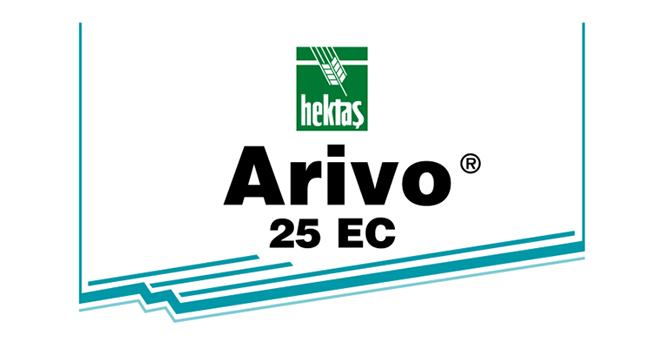
ARİVO® 25 EC
Active Ingredient : 250 g/L Cypermethrin
Formulation : EC (Emulsion concentrate)
Packaging : 1 lt, 100ml, 250ml, 5lt
Specifications
Arrivo 25 EC is an insecticide with synthetic pyrethroides which has contact and stomach poison action. It has nutrition stopping effect.
Method Of Application
Leaf psyllid of pistachio: When 20-30 nymphs per leaf are observed as a result of weekly counts on 100 compound leaves against pistachio psyllid, when majority of eggs are open and before the first mature parasitoid emergence and the adhesive surface (fumagine) on the leaf surface, administration should be made.
Pear psylla: When almost all of the eggs left by the wintering progeny matures are open and second & third term nymphs begin to appear; when contamination is observed in more than 15% of shoots; when the flow of sweetish substance does not start and when natural enemies are absent; one administration may be sufficient.
Against cotton bollworm in sunflower, spraying is started when egg, first period larvae or first signs of damage are observed in 5 of 100 plants.
In grapevine moth management, sprayings are done according to a forecast and warning system. If the number of moths caught in traps has reached peak and started to fall; accumulated degree-days reach 120 degree-days in the first generation, 520 degree-days in the second generation and 1047 degree-days in the third generation; and if, from a phenological perspective, first generation corresponds to the flower bud stage, second generation to unripe grape and third generation to start of sweetening; eggs are checked and spraying is decided according to hatching. One spraying is done for each generation.
Cowpea bruchids: Considering the development of the variety and the sowing time in the areas known to be contaminated, 2-3 spraying are administered with an interval of 10-14 days as soon as the lower capsules enter into dry state and contamination in the field is prevented.
The administrations to be made against apple codling moth should be guided according to forecast and early warning system. The aim in the management is to keep the trees medicated during the larvae emergence of each progeny, and to kill the larvae coming from egg before entering into fruit. Forecast and early warning system is not considered in pear.
After the start of the harmful grasshopper nymphs in the reservation (Tree Planting) areas against grasshoppers and in the surveys, after detecting the suitable density, chemical management is started immediately.
Against sunn pest in cereals, chemical management is decided according to the counts in the fields and assessments.
Against goat moth of cheery, sexual traps are hang in contaminated gardens, mature emergences are monitored. At the end of mature emergence or in mid-August and early September when young larvae in colony just below the tree trunk bark are observed, spraying is started. Second spraying is made depending on the duration of the product.
Care should be taken to spray all the trees and fruits, especially the top branches of big trees in coated administration against cherry fruit fly.
Corn: The first spraying is done after the first eggs of the pest are seen, followed by 3 sprayings done at 15-day intervals.
Against cotton bollworm in chickpea, 50-100 plants are inspected according to the size of the field by entering the field from the direction of diagonals, and egg and larvae is sought in the flowers, leaves, stems, fruits and shoots of the plant. If 5 of 100 plants are found contaminated, administration is made.
Against tobacco whitefly in tomato, the field is entered from the direction of diagonals. In the broad-leaved plants, in every five steps, 50 leaves are collected from the lower, middle and upper leaves. When there are 5 larvae+pupa per leaf, administration is made.
Cotton bollworm in tomato: Treatment is immediately started if 5/100 plants are found to be contaminated.
Against tobacco whitefly in eggplant, the field is entered from the direction of diagonals. In the broad-leaved plants, in every five steps, 50 leaves are collected from the lower, middle and upper leaves. When there are 5 larvae+pupa per leaf, administration is made.
Against large Narcissus fly in ornamental plants, when the size of plant is 10 cm, approximately 1000 onions per decare should be inspected to represent the field and if the contamination rate is 5%, a management should be made. When the mature emergences start, the first spraying should be made 10 days after the first emergence for both pests.
Compatibility: It can be mixed with some crop protection products except with alkaline properties. A trial mix is recommended before large-volume mix preparation
